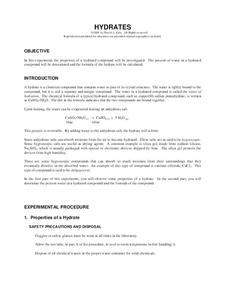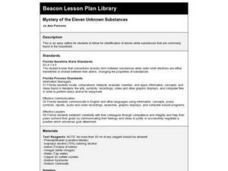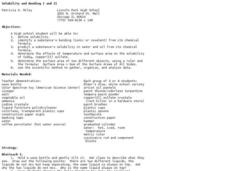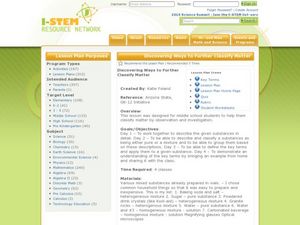Curated OER
Sea Water Freeze
Middle schoolers observe how salinity affects the time it takes water to freeze. They participate in an experiment to determine that ice is essentially salt-free whether formed from fresh or salt water
Chymist
Hydrates
What occurs when a hydrate is heated? Lead your class in exploring the answer to this question as they investigate the properties of a hydrated compound. They heat copper(II) sulfate pentahydrate and evaporate the water byproduct to...
Curated OER
Primary Biological Content Area
Students complete activities to learn about the growth process for crystals. In this crystal growth instructional activity, students use the given materials to complete a liquid bluing activity. Students observe and analyze the growth of...
Scholastic
Lesson Five: The Earth, Rocks and Minerals
Apply the principles of geology to a series of collaborative, hands-on class activities. Young earth scientists learn more about igneous, metamorphic, and sedentary rocks before classifying and weathering rocks that they find....
Curated OER
Coal Flowers
Students observe the effect of various chemicals on coal. Using coal, laundry bluing, water, salt, and ammonia, they observe crystal formations after a period of a few hours, and discuss their observations.
Curated OER
The History of Creation
Students explore the properties of matter. In this lesson about matter, students will do a series of experiments to enable them to understand about creation of the universe. In these some of the experiments students will makes stars,...
Curated OER
Minerals
Students define the characteristics of a mineral. In this geology lesson, students are given out various materials to observe such as a chicken bone, salt shaker, white paint, and chalk. Students categorize the items and are told what...
Curated OER
Solutions, Suspensions, and Colloids
In this solutions, suspension, and colloids worksheet, middle schoolers answer questions as it relates to their reading information about solutions, suspensions, and colloids. Students observe different examples and complete a chart as...
Curated OER
Sea Ice
Students observe the freezing times and temperatures of water with varying levels of salinity. They determine how icebergs form, how they act, and what they may be made of. They discover that salinity level affects the time it takes...
Curated OER
How Organisms Respond to Changes in their Environment
High schoolers observe the reaction of living cells to mechanical and chemical stimuli by introducing different stimuli to an organism under a microscope and recording the response.
Curated OER
Physical Difference and Classification
Students use a microscope and observation skills to compare and contrast several physical properties and develop a classification system.
Curated OER
Mystery of the Eleven Unknown Substances
Fourth graders identify eleven white substances that are commonly found in the household. They, in pairs, perform experiments on a variety of substances, and must identify them based on the reactions they observe.
Curated OER
A Creative Classroom Model For a Sixth Grade Science Class
Sixth graders observe with a microscope such simple crystals as salt, sugar, cream of tartar, and other chemicals which are listed in detail. They observe the crystalline structure and make comparisons, culminating in the creation of...
Polar Trec
Ice Cores: Modeling Ice Sheets
Ice cores provide scientists with knowledge of historic melt layers, air temperatures, greenhouse gases, and climate stability. Scholars work in groups to build layers representing snow and ice over thousands of years. Then, groups...
Curated OER
Ice
Students examine the different propereties of ice, such as freezing temperature. In this scientific lesson students complete several activities using ice, like making ice cream.
Curated OER
Geology Activities: Rock Making
Young scholars create their own gems using a simple experiment and learning process in class.
Curated OER
Introductory Microbiology
Learners view a Reading Rainbow video on germs and discuss microbial diseases. They grow cultures of Staphylococcus aureus and then estimate and graph the count for their own bodies and those of the class.
Curated OER
What's the Matter? Where Did it Go?
Eighth graders analyze questions posted on a large poster in the room and work in groups to record their response to the question on paper, rotating to the next question after two minutes have passed. They review the characteristics of...
Curated OER
Discover Ways to Further Classify Matter
Middle schoolers analyze and classify substances. In this classifying matter lesson, students look at various substances and identify them as heterogeneous or homogeneous mixtures, pure substances, or solutions. Middle schoolers bring...
Curated OER
Ice Cream
Students explore the concept of the colligative property. Through experimentation, students lower the freezing point of a liquid in order to create a solid by using household ingredients to create ice cream.
Curated OER
Quick Freeze (Demonstration)
Students witness an demonstration in which a bottle of club soda will go from a liquid to a solid when it is opened and the carbon dioxide is allowed to escape. This will help them understand that the freezing point of a solution will...























